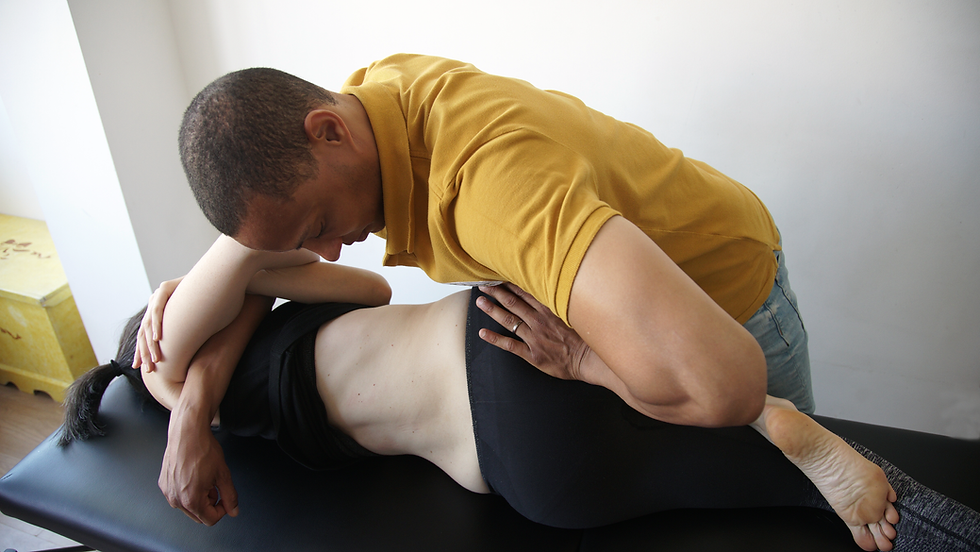Physiotherapy in Hip Replacement: Recovery and Essential Care
- Ricardo Vargues - Fisioterapeuta
- Apr 11, 2024
- 3 min read

Hip replacement, also known as hip arthroplasty, is a common orthopedic surgery performed to replace the damaged or worn-out hip joint (osteoarthritis/arthrosis).
This surgery contributes to improving the quality of life for individuals with significant pain and disability in the hip joint. After surgery, physiotherapy plays a vital role in the patient's recovery, helping to restore functionality, reduce pain, and improve mobility. In this article, I will explore the importance of physiotherapy after hip replacement surgery and the essential care for successful recovery, providing answers to frequently asked questions on this topic.
The importance of physiotherapy for recovery after hip replacement.
With a personalized rehabilitation plan, physiotherapy plays a key role in recovery after this surgery. This plan focuses on:
Managing pain and reducing swelling: Application of ice, specific therapeutic exercises help reduce inflammation and improve blood circulation, speeding up the healing process.
Restoring mobility, muscle strength, and joint stability: Strengthening and stretching exercises will help improve stability, increase ranges of motion, and prevent falls.
Accelerating the healing and recovery process: Preventing complications such as muscle contractures and scar adhesions.
Recovering normal functionality and facilitating return to daily activities.
Important factors during rehabilitation.
During the rehabilitation process, it is essential to follow some important recommendations:
Adherence to the treatment plan: It is essential to take an active role in the rehabilitation process that you and I have designed for your recovery to be successful.
Avoid overloading: Avoid lifting heavy objects or engaging in activities that may exert excessive stress on the operated hip. As you progress in your rehabilitation, it is natural to feel an increase in confidence, which may lead you to overdo the exercises and your daily activities. However, this excess often results in setbacks in the progress you have achieved up to this point.
Monitor progress: My approach aims to inform and educate about the entire rehabilitation process. This way, we can maintain aligned communication, ensuring that any concerns or difficulties you may have are always addressed. If it is necessary to adjust our treatment plan, we will be ready to do so.
Frequently Asked Questions about Physical Therapy for Hip Replacement.
Here are some frequently asked questions about physical therapy for hip replacement surgery, along with their respective answers:
How long does it take to fully recover from hip replacement surgery?
Full recovery varies from person to person, usually taking 3 to 6 months. However, it's important to continue with physical therapy exercises even after the initial recovery.
What are the benefits of physical therapy for hip replacement surgery?
Physical therapy helps reduce pain, improve mobility, increase muscle strength, and speed up overall recovery after hip replacement surgery.
What activities should be avoided during recovery?
During recovery, it's important to avoid high-impact activities such as running and jumping. I will provide specific guidance based on the individual progress of the patient.
When can I return to my normal activities?
The return to normal activities will depend on individual recovery and guidance from the orthopedic surgeon. Generally, higher-impact activities are gradually resumed after about 3 to 6 months.
Is it normal to feel pain during physical therapy?
Some pain and discomfort are normal during physical therapy, especially in the early stages of recovery. However, physical therapy exercises and techniques are adjusted based on the patient's tolerance.
When should I contact my doctor or physical therapist?
It's important to contact the doctor or physical therapist if serious complications occur, such as a significant increase in pain, excessive swelling, or any other urgent concern.
Conclusion
Physical therapy plays a crucial role in the recovery after hip replacement surgery. Following post-operative care and performing recommended exercises are essential for achieving successful recovery.
Relieving pain, improving range of motion, strengthening muscles, and restoring hip functionality are the benefits of undergoing physical therapy.
Remember that each person is unique, and recovery may vary. Therefore, consulting your doctor and physical therapist for personalized guidance throughout the rehabilitation process is important.
Return to enjoying an active life, free from pain, and with restored mobility. Schedule your assessment now so that together we can achieve the best results.
Ricardo Vargues | Physiotherapist
References:
Souza, R. O., Carvalho, R. L. C., & Prado, N. B. (2014). Fisioterapia na prótese total de quadril: uma revisão sistemática. Fisioterapia e Pesquisa, 21(3), 298-306.
Sardini, S. R., & Ribeiro, D. M. (2017). Protocolo de fisioterapia na prótese total de quadril: uma revisão de literatura. Revista Brasileira de Ortopedia, 52(3), 253-262.
Fernandes, T. C., Pereira, L. C., Santos, C. A., & Soares, D. P. (2018). Fisioterapia na reabilitação pós-operatória de pacientes submetidos à artroplastia total de quadril. Fisioterapia Brasil, 19(4), 473-479.
Rezende, M. U., & Fernandes, R. M. (2020). Importância da fisioterapia na reabilitação após artroplastia total de quadril. Revista Brasileira de Reabilitação, 24(2), 95-102.









Living with ALS has been one of the hardest challenges of my life.The muscle weakness, fatigue, and gradual loss of mobility were heartbreaking. Conventional treatments offered little more than temporary comfort, and I was starting to lose hope.That’s when I discovered NaturePath Herbal Clinic.Skeptical but desperate for relief, I decided to try their herbal therapy. To my surprise, by the fourth month, I began noticing steady improvements less muscle twitching, better coordination, and renewed energy. It wasn’t an overnight miracle, but the progress felt real. For the first time in a long while, I felt a sense of control returning to my body.Today, I move more freely, sleep better, and most importantly I feel hopeful again. This journey with NaturePath…